Introduction
Biogas sludge is the waste by-product from an anaerobic processing system (FAO, 1977) and has a high nutrient content that can be used as organic fertilizer to increase soil fertility and plant yield (Adela et al., 2014). The following characteristics of the biogas sludge from palm oil waste have been reported: total N of 490 mg L-1, total P of 110 mg L-1, total K of 1.9 mg L-1 (Lubis et al, 2014), C/N 8; 0.14% N, 1.12% C (Tepsour et al., 2019), and N-NH3 of 91-112 mg L-1 (Choorit & Wisarnwan, 2007). The pH may range from 6.8 to 8.3, with the highest bacterial population of 7.21x107 cells ml-1 and the lowest of 3.15x107 cells ml-1 (Alvionita et al., 2019). Additionally, Mustamu and Triyanto (2020) reported that the biogas sludge has nitrogen-fixing and phosphate solubilizing bacteria that have the potential to increase the availability of nitrogen and phosphate in soils.
The diversity of beneficial bacteria such as nitrogen-fixing and phosphate solubilizing bacteria has a greater potential to increase soil fertility and plant growth. Zhang et al. (2013) reported that phosphate solubilizing bacteria play an important role in increasing soil fertility and plant yield, and reducing the use of chemical fertilizers. Sharma et al. (2013) described different Bacillus species, such as B. circu-lans, B. cereus, B. fusiformis, B. pumilus, B. megaterium, B. mycoides, B. coagulans, B. chitinolyticus, and B. subtilis as phosphate solubilizing microorganisms. Ambrosini et al. (2016) showed the highest nitrogenase activity in Bacillus cereus among 42 different strains of Bacillus spp. Lim et al. (2018) also reported the dominant bacteria found in the biogas sludge from anaerobic processing using the pyrosequencing and clone library methods, i.e., Proteobacteria, Firmicutes, Bacteroidetes, and Thermotogae.
The application of bacteria from biogas sludge has never been reported in Indonesia for improving upland rice growth on acidic soils, including Ultisols. According to the Pusat Penelitian Tanah dan Agroklimat (Center for Soil and Agro-climate Research) (2000), the area in Indonesia covered by Ultisols is 45.8 million ha or 24% of the total area of the country. Furthermore, according to the Ministry of Agriculture, the area dedicated to rice cultivation in Indonesia is 15,712,025 ha with a yield of 81,148,617 t in 2017, and the contribution of upland rice yield is 4.66% (Kementerian Pertanian, 2017). The yield contribution of upland rice is classified as low and, therefore, it is necessary to find options to increase it. Therefore, it is necessary to test the potential of beneficial bacterial isolates from biogas sludge to increase the availability of nitrogen and phosphate and, thus, the growth response of upland rice in Ultisols. This study aimed to evaluate the influence of selected superior bacterial isolates, biogas sludge, and their interaction on the mineral nutrition of the upland rice grown in Ultisols.
Materials and methods
Study area
The concentration of total N and available P in Ultisols and in the plant tissue (N and P uptake) were analyzed in the Analytical Laboratory of Socfin Indonesia Inc., Medan (Indonesia). The bacterial isolates were applied to upland rice in the village of Padang Bulan (3°37.760' N, 98°38.898' E, and altitude of 18 m a.s.l.), Medan Selayang Subdistrict, Medan City, Indonesia, from October 2020 to April 2021. The average temperature was 27.4°C, the average air humidity was 82%, and the average rainfall was 228.5 mm per month.
Preparation of medium and upland rice seeds
The medium to grow upland rice plants was the Ultisol soil from the Simalingkar area, Medan Tuntungan Subdistrict, Medan City, collected at a depth of 0 to 20 cm. One hundred g of soil sample were taken and analyzed for chemical characteristics of pH H2O, organic C by Walkley-Black, available P by Bray-II, total N using the Kjeldahl method, and cation exchange capacity (CEC) and base saturation (K, Ca, Na, Mg) by ammonium acetate pH7 method (Tab. 1). The soil was sterilized by drying at 100°C for 2 h. To prevent heat from the sterilization process, the soil was incubated for 1 d and then placed into a 10 kg polybag (18 cm x 18 cm). A basic NPK fertilizer (16-16-16) by Meroke Tetap Jaya Inc. (Medan, Indonesia) at a dose of 1.5 g/poly-bag was applied by stirring evenly with the soil. The seeds of upland rice (Oryza sativa L.) of the inbred variety Inpago-8 from the Indonesian Agency for Agricultural Research and Development were soaked in water for 24 h, followed by the application of the fungicide Propineb (70%) for 2 h. Upland rice was planted after 1 d of basic fertilization with two seeds per polybag at a depth of 2 cm.
TABLE 1 Chemical characteristics of the Ultisol soil samples after sterilization at 100°C.
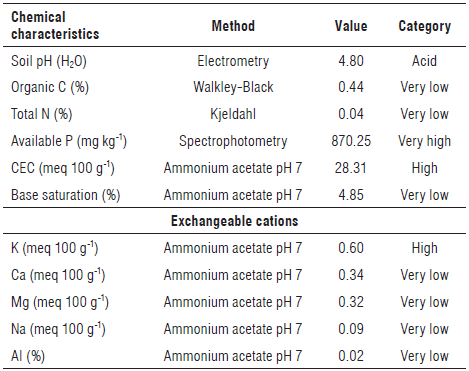
Criteria for pH (H2O) = 4.5-5.5 (acid); organic C <1% (very low); total N <0.1% (very low); available P >60 mg kg-1 (very high); cation exchange capacity (CEC) = 25-40 meq 100 g-1 (high); base saturation <20% (very low); exchangeable K = 0.60-1.00 meq 100 g-1 (high); exchangeable Ca <2 meq 100 g-1 (very low); exchangeable Mg <0.4 meq 100 g-1 (very low); exchangeable Na <0.1 meq 100 g-1 (very low); exchangeable Al <5% (very low) (Balai Penelitian Tanah (Indonesia Soil Research Institute), 2009).
Preparation of superior bacterial isolates suspension and biogas sludge
One ml of the bacterial isolate suspension obtained from the characteristic stage was put into a test tube containing 9 ml of distilled water, homogenized and then diluted to 10-5. A total of 0.1 ml of the suspension from the last dilution was spread over James nitrogen free malat bromothymol blue (JNFB) medium (Kirchhof et al., 1997) for the nitrogen-fixing bacterial isolates test and Pikovskaya (PVK) medium ( Pikovskaya, 1948) for the phosphate solubilizing bacteria isolates. The culture medium was incubated for 2 to 3 d at 37°C. The nitrogen-fixing bacterial isolate test was characterized by the presence of colonies growing on the JNFB medium. The growth of phosphate solubilizing bacterial isolates was indicated by a halo zone around the microbial colonies on the PVK medium. Seven nitrogen-fixing and seven phosphate-solubilizing isolates were found to produce total N and available P. The isolates that showed the highest phosphate and nitrogen increasing abilities were selected, namely phosphate solubilizing bacteria (P7) and nitrogen-fixing bacteria (N3), which were confirmed by Mustamu et al. (2021a; 2021b).
The biogas sludge was collected from Nubika Jaya Inc., Pinang City, Labuhanbatu District, North Sumatra Province, Indonesia. The procedure for processing biogas sludge was the following: the palm oil mill removed the palm oil mill effluent (POME) waste from the second pond which has been mixed with oil and then separated at an optimal temperature of 35°C. Liquid waste was then pumped into the receiver tank of 10 m3 volume and filtered on a fiber tank screen to separate solid waste such as fiber and other materials. Liquid waste from the receiver tank was further pumped into the tower tank. Then, it was distributed evenly to the fixed tank at a temperature of 35 to 37°C and a flow rate of 20 to 30 m3/h. Finally, the biogas sludge was taken from the fixed tank. Bacterial isolates and biogas sludge were applied to the soil surface at the base of the plants at one week after planting. Biogas sludge samples of 500 ml volume were used to analyze the chemical and biological characteristics (Tab. 2).
TABLE 2 Chemical and biological characteristics of the biogas sludge.
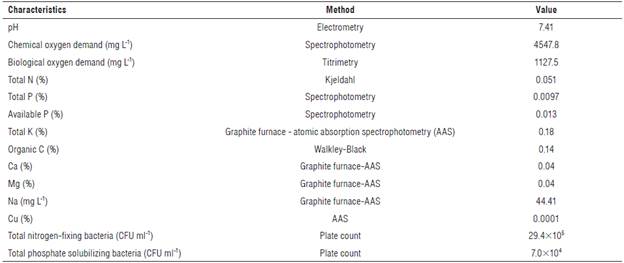
Laboratory analysis based on the Balai Penelitian Tanah (Indonesia Soil Research Institute) (2009).
Treatment application
This study used a randomized block design with two factors and seven replicates. The first factor was the type of superior bacterial isolates (B0 = untreated; B1 = nitrogen-fixing bacterial isolate (N3); B2 = phosphate solubilizing bacteria isolate (P7); B3 = combination of isolates N3+P7) at a similar dose, namely 10 ml/polybag. The second factor was the dosage of biogas sludge (S0 = untreated; S1 = 157.5; S2 = 315; S3 = 630 ml/polybag). Determination of biogas sludge based on the dose of liquid organic fertilizer at the oil palm was 126 m3 ha-1 equal to 126,000 L ha-1 (Sutarta et al., 2000), then converted to soil weight per polybag (Eq. 1). Each replicate was harvested at 4, 8, and 12 weeks after application (WAA) for determination of the crop growth rate (CGR)
Plant growth variables and data analysis
The growth variables were assessed by measuring the growth of upland rice (plant height, and total fresh and dry weights), contents and uptake of N and P in the aerial parts, and crop growth rate (CGR). The plant height was measured from the root apex to the tip of leaves using a measuring tape, and the total fresh weight was obtained by weighing the roots and shoots. The total dry weight (roots + shoots) was obtained after plant drying in an oven (VS-1202D3, Vision Scientific Co., Korea) at 60°C for 48 h and weighed using analytical scales. A 200 g sample of the second leaf from the shoots was collected and analyzed to determine the N content using the Kjeldahl method, and the P content was recorded using the destruction method through dry ashing (Bertramson, 1942). The N and P uptake were measured using Equation 2. The CGR was calculated as the dry weight related to the unit area at 4-8, 8-12, and 12-16 WAA using Equation 3 (Shon et al, 1997):
where:
CGR = crop growth rate;
W1 = dry weight per unit area at tl;
W2 = dry weight per unit area at t2;
t1 = first sampling;
t2 = second sampling.
The parameters of the second phase of the study were analyzed by an ANO VA. If the treatment had a significant effect, the Duncan's multiple range test was applied at P<0.05 using SPSS V.20 software (IBM, 2011).
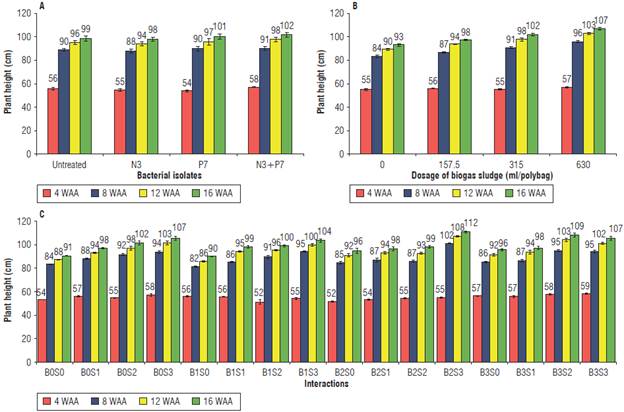
FIGURE 1 A) Effect of superior bacterial isolates, B) dosage of biogas sludge, and C) their interactions on plant height of upland rice at 4, 8,12, and 16 weeks after application (WAA). Values followed by a different letter in the graph significantly differed according to the Duncan test at P<0.05. Vertical bars indicate the standard error. Dosage of biogas sludge (SO = untreated; S1 = 157.5; S2 = 315; S3 = 630 ml/polybag). Superior bacterial isolates (B0 = untreated; B1 = isolate N3, B2 = isolate P7; B3 = isolates N3+P7).
Results
Effect of bacterial isolates and biogas sludge on upland rice growth
Plant height of upland rice
The effect of biogas sludge application was significant on the plant height of upland rice at 8, 12, and 16 WAA. Superior bacterial isolates and their interactions did not have a significant effect on the plant height of upland rice at 4, 8, 12, and 16 WAA (Fig. 1A-C). A significant increase in plant height of upland rice was observed with higher doses of biogas sludge of 630 ml/polybag at 8, 12, and 16 WAA, with the highest increase of 14.81% compared to the control at 16 WAA. Although the effect was not significant, the combination of isolates B3 and the interaction of B2S3 showed the highest increase in plant height of upland rice by 2.94% and 22.06%, respectively, compared to the control.
Biomass of upland rice
The effect of biogas sludge significantly increased the total fresh weight of upland rice at 8, 12, and 16 WAA. Superior bacterial isolates and their interactions did not have a significant effect on the total fresh weight of upland rice at 4-16 WAA (Tab. 3).
TABLE 3 Effect of superior bacterial isolates, biogas sludge, and their interactions on the total fresh weight (shoot + roots) of individual upland rice plants at 4, 8, 12, and 16 weeks after the application (WAA).
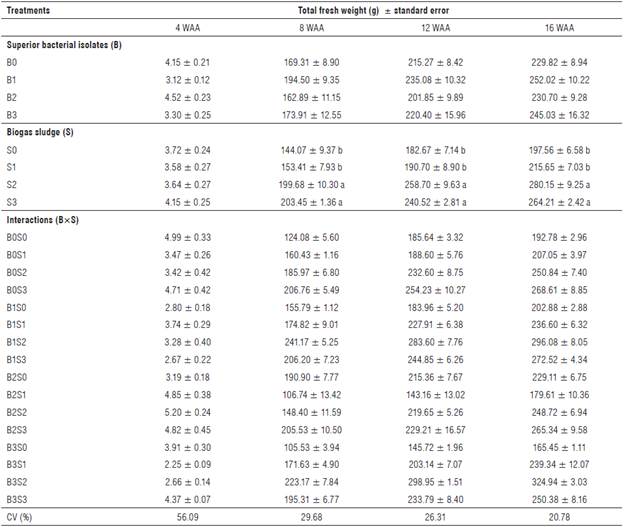
Values followed by a different letter In the column significantly differed according to the Duncan test at P<0.05. CV - coefficient of variation. Dosage of biogas sludge (S0 = untreated; S1 = 157.5; S2 = 315; S3 = 630 ml/polybag). Superior bacterial isolates (B0 = untreated; B1 = isolate N3, B2 = isolate P7, B3 = isolates N3+P7).
A significant increase in the total fresh weight of upland rice was observed with the higher dose of biogas sludge of 315 ml/polybag at 16 WAA, with the highest increase of 41.81% compared to the control. Although the effect was not significant, B1 and the interaction of B3S2 showed the highest increase in the total fresh weight of upland rice with 9.66% and 68.55%, respectively, compared to the control.
The effect of biogas sludge significantly increased the total dry weight of upland rice at 12 and 16 WAA. Superior bacterial isolates and their interactions had an insignificant effect on the total dry weight of upland rice at 4-16 WAA (Tab. 4).
TABLE 4 Effect of superior bacterial isolates, biogas sludge, and their interactions on the total dry weight (shoot + roots) of individual upland rice plants at 4, 8, 12, and 16 weeks after the application (WAA).
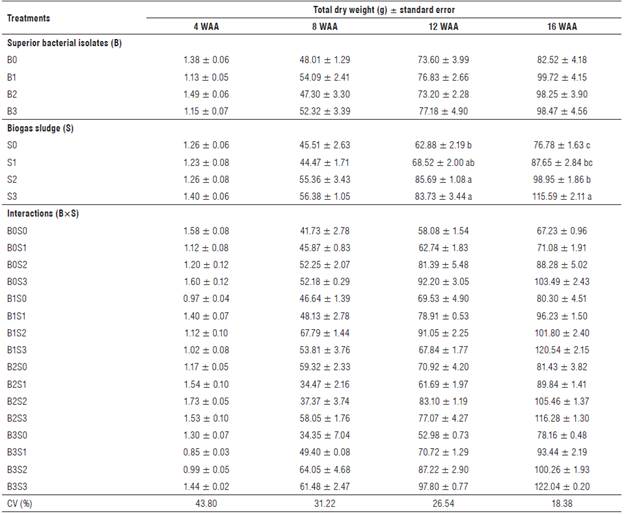
Values followed by a different letter in the column significantly differed according to the Duncan test at P<0.05. CV - coefficient of variation. Dosage of biogas sludge (S0 = untreated; S1 = 157.5; S2 = 315; S3 = 630 ml/polybag). Superior bacterial isolates (B0 = untreated; B1 = isolate N3, B2 = isolate P7, B3 = isolates N3+P7).
A significant increase in the total dry weight of upland rice was observed with the increase in the dosage of biogas sludge of 630 ml/polybag at 16 WAA, with the highest increase of 50.55% compared to the control. Although the effect was not significant, B1 and the interaction of B3S3 showed the highest increase in the total dry weight of upland rice with 20.84% and 81.53%, respectively, compared to the control.
Crop growth rate of upland rice
The effect of superior bacterial isolates, biogas sludge, and their interactions significantly increased the crop growth rate of upland rice at 12-16 WAA but did not have a significant effect at 4-8 and 8-12 WAA (Tab. 5).
TABLE 5 Effect of superior bacterial isolates, biogas sludge, and their interactions on the crop growth rate of the upland rice 4, 8, 12, and 16 weeks after the application (WAA).
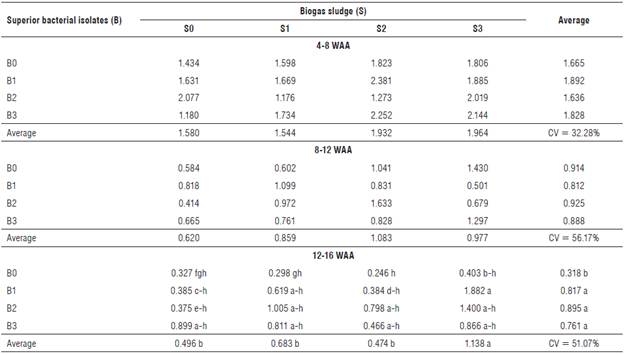
Values followed by a different letter in the column significantly differed according to the Duncan test at P<0.05; CV - coefficient of variation. Dosage of biogas sludge (S0 = untreated; S1 = 157.5; S2 = 315; S3 = 630 ml/polybag). Superior bacterial isolates (B0 = untreated; B1 = isolate N3, B2 = isolate P7, B3 = isolates N3+P7).
The biogas sludge dose of630 ml/polybag (S3) significantly increased the highest crop growth rate for upland rice at 12-16 WAA by 129.44% compared to the control. The isolates B1-B3 significantly increased the crop growth rate of upland rice with the highest increase for B2 of 181.45% compared to the controls at 12-16 WAA. The interaction of B1S3 significantly increased the crop growth rate of upland rice, showing values 5.76 times greater than those of the control.
Effect of bacterial isolates and biogas sludge on upland rice nutrition
Contents of N and P in the upland rice
The effect of biogas sludge, superior bacterial isolates, and their interactions did not have a significant effect on the content of N and P in the upland rice (Fig. 2A-C). The biogas sludge doses of 315 and 630 ml/polybag (S2 and S3) increased P and N in the plant tissue of upland rice by 33.33% and 4.53%, respectively, compared to the control. The isolate B2 showed the highest content of N in the plant tissues of upland rice with values 1.63% higher than those of the control. However, all isolates (B1-B3) showed a similar level of P in the plant tissues of upland rice compared to the control.
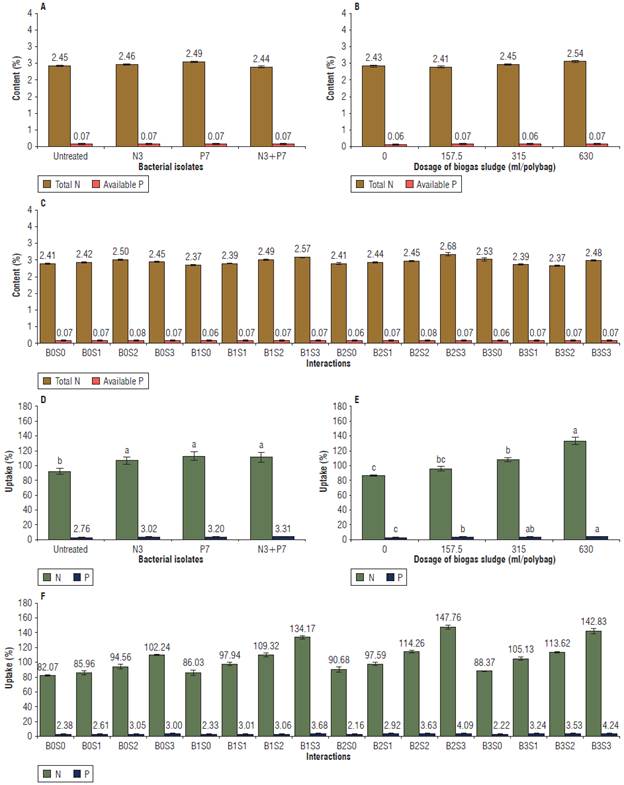
FIGURE 2 Effect of superior bacterial isolates, dosage of biogas sludge, and their interactions on the nutrient content (A-C) and uptake of N and P (DF) of upland rice. Values followed by different letters significantly differed according to the Duncan test at P<0.05. Vertical bars indicate the standard error. Dosage of biogas sludge (SO = untreated; S1 = 157.5; S2 = 315; S3 = 630 ml/polybag). Superior bacterial isolates (BO = untreated; B1 = isolate N3, B2 = isolate P7, B3 = N3+P7 isolates).
Uptake of N and P in the upland rice
The effect of biogas sludge significantly increased the uptake of N and P. The superior bacterial isolates significantly increased the uptake of nitrogen. The interaction of biogas sludge with superior bacterial isolates did not show a significant effect on the uptake of N and P in the upland rice (Fig. 2D-F).
A significant increase in the uptake of N and P in upland rice was observed with a higher dose of biogas sludge of 630 ml/polybag, with the highest increases of 54.11% and 65.20%, respectively, compared to the control. The bacterial isolates B1-B3 also significantly increased the uptake of N in the upland rice with the highest increase with B2 of 20.77% compared to the control. Although the effect was not significant, B3 showed the highest uptake of P in the upland rice of 19.93% compared to the control.
Discussion
Effect of selected superior bacterial isolates
The selected superior bacterial isolates (N3 and P7) significantly increased the uptake of nitrogen and the crop growth rate of upland rice in an Ultisol at 12-16 WAA but did not have a significant effect on plant height, total fresh weight, total dry weight, content of N and P in leaves, uptake of phosphorus by the plants, and crop growth rate of upland rice from 4 to 12 WAA. The superior bacterial isolates (N3, P7, and N3+P7) increased the uptake of nitrogen in upland rice by 14.64%, 20.77%, and 20.68%, respectively, compared to the control (Fig. 2). Similar results are also shown in Table 5, with the crop growth rate of upland rice at 12-16 WAA increased by 2.57, 2.81, and 2.39 times, respectively, due to the selected superior bacterial isolates (N3, P7, N3+P7) compared to the control. The results indicate that a single P7 bacterial isolate increased the nitrogen uptake and crop growth rate of upland rice compared to a single N3 isolate and the combination of N3+P7 isolates. This was due to the presence of several organic acids and hormones produced by the isolate P7 that can increase the uptake of nitrogen and crop growth rate of upland rice. This result is supported by Mustamu et al. (2021a) who found that the phosphate solubilizing bacterial isolate (P7) from the biogas sludge contains organic acids, such as lactic, oxalic, acetic, and citric, and had the highest ability to solubilize phosphate from calcium triphosphate and rock phosphate with values 4.62 and 2.66 times higher, respectively, compared to the control. Meena et al. (2016) reported that the availability of nitrogen and phosphorus in soils slightly increased with the application of bio fertilization with Bacillus cereus. This was due to the production of organic acids and other substances, including citric, tartaric, and oxalic acids, that can stimulate plant growth and nutrient availability. Youssef and Eissa (2017) reported that the increase in vegetative growth and total biomass was due to increased photosynthesis, translocation, and accumulation of mineral nutrients. Khan et al. (2020) reported that Bacillus cereus strain SA1 can produce the hormones gibberellin, indole-acetic acid (IAA), and organic acids. Ferrara et al. (2012) reported that gibberellin and IAA can increase plant growth under stressful conditions. Kang et al. (2014) indicated that the plant growth-promoting bacteria (PGPB) has several mechanisms to increase plant growth with nitrogen-fixation and phosphate solubilization, increasing nutrient availability. Suksong et al. (2016) reported that bacteria of palm oil solid waste from an anaerobic digester include Ruminococcus sp., Thiomargarita sp., Clostridium sp. Anaerobacter sp., Bacillus sp., Sporobacterium sp., Sac-charofermentans sp., Oscillibacter sp., Sporobacter sp., and Enterobacter sp. Liaquat et al. (2017) also reported abundance of Bacillus, Clostridium, and Enterobacter spp. in an anaerobic digester of wastewater when producing biogas.
Effect of biogas sludge
The dose of biogas sludge significantly increased the plant height, total fresh weight (8, 12, and 16 WAA), total dry weight (12 and 16 WAA), uptake (N and P), and crop growth rate of upland rice at 8-12 WAA. However, it did not have a significant effect on the content (N and P) in leaf tissue, and crop growth rate of upland rice (4-8 and 8-12 WAA). An increase in plant height, total dry weight, uptake of nitrogen and phosphorus, and also crop growth rate of upland rice in an Ultisol with a higher dose of biogas sludge of 630 ml/polybag was seen at the end of this study (16 WAA). In contrast, the total fresh weight increased along with the higher dose of biogas sludge of 315 ml/polybag and then decreased at the dose of 630 ml/polybag. This result is due to the chemical characteristics of the biogas sludge such as pH (7.41), total N (0.051°%), available P (0.013%), organic C (0.14%), total K (0.18%), and the biological characteristics such as total nitrogen-fixing bacteria (29.4x105 CFU ml-1) and total phosphate solubilizing bacteria (7.0x104 CFU ml-1) (Tab. 2). The organic C content and the total population of nitrogen-fixing and phosphate solubilizing bacteria from the biogas sludge could increase the uptake of nitrogen and phosphorus in upland rice with an increasing dose of biogas sludge of630 ml/polybag (Fig. 2). Therefore, the nutrients absorbed are used for plant metabolic processes and stimulate the plant height, biomass, and crop growth rate of the upland rice. A similar result was reported by Mustamu and Triyanto (2020), who determined the macro and micronutrients from the biogas sludge and the population of nitrogen-fixing and phosphate solubilizing bacteria of 480x104 and 42x104 CFU ml-1, respectively. Ndubuisi-Nnaji et al. (2020) reported that the total phosphate solubilizing bacteria (1.6 to 2.5 CFU ml-1) was significantly higher than nitrogen-fixing bacteria (0.5-1.4 CFU ml-1), showing a significant increase in nutrient concentration in the order of N>K>P>Ca>Mg>S in all anaerobic digester bioreactors. Möller and Müller (2012) reported an increase in concentrations of NH4+-N from 45% to 80% in the anaerobic waste.
Interaction of selected superior bacterial isolates and biogas sludge
The interaction of biogas sludge and superior bacterial isolates only significantly increased the crop growth rate of upland rice in Ultisols at 12-16 WAA but did not have a significant effect on the other parameters in this study. The interaction of B1 with biogas sludge at the dose of 630 ml/polybag (B1S3) showed the highest crop growth rate of upland rice compared to other interactions and was 5.76 times greater compared to the control. This was caused by the application of biogas sludge that could have increased soil organic matter and the total population of beneficial bacteria. Likewise, the biogas sludge contained organic C (0.14%), total nitrogen-fixing bacteria (29.4x105 CFU ml-1), and total phosphate solubilizing bacteria (7.0x104 CFU ml-1) (Tab. 2) that could improve soil quality and increase the CGR. This result is supported by Urra et al. (2019) who found that the application of sewage sludge in the long term significantly increases the organic matter contents in the soil, causing a decrease in soil pH due to the nitrification of ammonium in sewage sludge and the production of organic acids along with the decomposition of the organic matter. Bhardwaj et al. (2014) and Carvajal-Muñoz and Carmona-Garcia (2012) showed that the application of a biofertilizer had advantages for the plants such as availability of nutrients balanced for plant health. It also stimulates nutrient mobilization that can increase soil biological activity and nutrient availability for microorganisms to encourage the growth of beneficial microorganisms, increasing the soil organic matter content and, therefore, the cation exchange capacity. Siswanti and Lestari (2019) indicated that the interaction of biogas sludge + biofertilizer (36 ml + 10 L ha-1) significantly increased the plant height, number of leaves, and capsaicin content in chili pepper compared to a single treatment of biogas sludge and biofertilizer.
Conclusions
The isolates N3, P7, N3+P7 from the biogas sludge significantly increased the uptake of nitrogen (20.77%) and crop growth rate (2.81 times higher than the control) of upland rice in Ultisols with the highest increase found with the P7 isolate. The dose of biogas sludge significantly increased plant height (14.81%), total dry weight (50.55%), uptake of nitrogen (54.11%) and phosphorus (65.20%), and also crop growth rate (129.44%) of upland rice in Ultisols with the highest increase at a dose of 630 ml/polybag. Likewise, the dose of biogas sludge significantly increased the total fresh weight of upland rice by 41.81% with the highest increase at the dose of 315 ml/polybag. The interaction of isolates N3, P7, N3+P7 with the dose of biogas sludge only significantly increased the crop growth rate of upland rice in Ultisols 5.76 times with the highest increase found with B1S3.

















